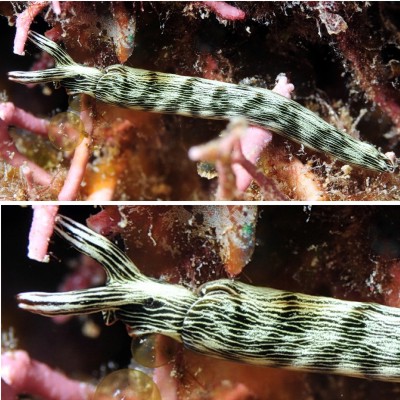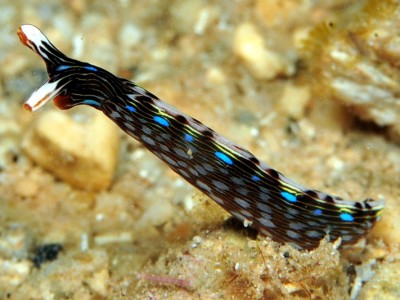Re: The foot of Thuridilla bayeri
May 14, 2010
From: John Fraser

Concerning message #21136:
Has anyone done DNA or recent radular tooth studies on T. gracilis, T. bayeri and other similar slugs? Here in Laulau Bay, Saipan, I find both what were/are called T. gracilis and T. bayeri. I have heard there are "expert" studies that have grouped them together but I cannot find the studies. Can you provide me with any leads? here are a couple examples from Laulau Bay. They are quite common there.
Locality: Laulau Bay, 30-40 feet, Saipan, Northern Mariana Islands, Pacific, 11 Jan 2010 and 25 Jan 2010, sand and rubble. Length: 10-20 mm. Photographer: John Fraser.
Thanks
John Fraser
johnfraser1@gmail.com
Fraser, J., 2010 (May 14) Re: The foot of Thuridilla bayeri. [Message in] Sea Slug Forum. Australian Museum, Sydney. Available from http://www.seaslugforum.net/find/23356
Dear John,
I discuss the T. gracilis - T. bayeri question on the T. gracilis Fact Sheet, where you will also find a reference to Gosliner's major review of the genus. Gosliner doesn't think T. gracilis is identifiable from its original description. However he considers an animal which has been named T. ratna (Marcus 1965), and has the same colour pattern as what I am calling T. gracilis, to be a colour form of the blue-spotted T. bayeri. So we both consider th blue-spotted and unspotted forms to be the same species. The difference is that I consider T. gracilis to be very recognisable from its original description, and as it is a much older name than T. bayeri I call the species by its oldest name - T. gracilis.
Have a look at the earlier messages attached to the T. gracilis Fact Sheet as they show the range in colour variation in the species and include an on-going discussion on the pros and cons of one or more species. For example, Clay Carlson tends towards two species. In many opisthobranchs there are taxonomic puzzles like this which will require more study before we have a definitive answer. If you have large populations of both then perhaps you could look for biological differences. Can you see consistent colour differences? Do they interbreed? Are their intermediate colour forms? Are their egg masses different? What do they eat? etc etc.
Best wishes,
Bill Rudman
Related messages
-
Thuridilla gracilis from S. E. Queensland
From: David Mullins, May 14, 2010 -
Thuridilla gracilis from Lembeh, Indonesia.
From: Brian Mayes, March 4, 2009 -
Thuridilla bayeri ? from Bangka Island, Indonesia
From: Francois Zylberman, October 13, 2008 -
Re: The foot of Thuridilla bayeri
From: Clay Carlson, December 3, 2007 -
The foot of Thuridilla bayeri
From: Clay Carlson, November 30, 2007 -
Possible colour variant of Thuridilla gracilis
From: Heidi Hösel, October 16, 2007 -
Thuridilla gracilis from West Papua
From: Wendy Atkinson, June 5, 2007 -
Mating Thuridilla gracilis from nthn Mariana Islands
From: Yuji Fujie, January 30, 2007 -
Sea grass hitch hiker
From: Charles Raabe, July 4, 2006 -
Thuridilla gracilis from Thailand
From: Nararongpon Sittithaweepat, September 29, 2005 -
Thuridilla from Mombasa, Kenya
From: Valérie Besnard, May 18, 2005 -
Thuridilla gracilis from Singapore
From: Lim Han Peng, April 28, 2005 -
Thuridilla bayeri? found in tank
From: Marc, February 14, 2004 -
Thuridilla from the Philippines
From: Erwin Koehler, February 11, 2002 -
Thuridilla bayeri ? from the Seychelles
From: Erwin Koehler, June 18, 2001 -
Re: Thuridilla gracilis from the Solomon Ids
From: Kathe R. Jensen, June 16, 2001 -
Thuridilla gracilis from the Solomon Ids
From: Bruce Potter, June 15, 2001 -
Thuridilla gracilis from Coral Sea
From: Des Paroz, October 29, 2000 -
Thuridilla bayeri & T. gracilis
From: C. Carlson & P.J. Hoff, September 28, 2000 -
Thuridilla from coral rock
From: Andrew Trevor-Jones, September 24, 2000 -
Thuridilla gracilis from Great Barrier Reef
From: Stuart Hutchison, August 12, 2000
